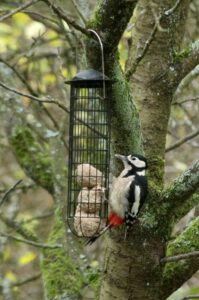 Christmas and New Year’s Eve are over. Now it’s already February, but Valentine’s Day is not really your thing? Worry not! National Bird-Feeding Month has arrived.
Christmas and New Year’s Eve are over. Now it’s already February, but Valentine’s Day is not really your thing? Worry not! National Bird-Feeding Month has arrived.
It’s just the right time of the year to provide our feathered friends with food and water in our backyards, then sit in front of the window to watch them. It’s a great delight to see them feast on seeds. You can get in touch with nature, take a moment to relax, and help the environment. It’s also cheap, and kids will have a lot of fun learning the different birds’ names.
You’re not familiar with the A and O of bird-feeding yet? Don’t worry about this either – I’ve been feeding birds in my yard for years. Let me feed you the most important titbits you need to know to participate!
In the United States, February is National Bird-Feeding Month. It was originally created in 1994 to educate the public about the needs of wild birds. People should then be more aware and more encouraged to help birds where and when they can. This month was chosen as it is a traditionally difficult one for wild birds. It’s harder for them to find both something to eat and drink – which you can easily help them with. All you have to do is put a bowl of water and some seeds into your gardens. Right? That would be the easiest way; if you can’t do more, that should be enough. But of course, you can always do more.
Different kinds of seeds will attract different kinds of birds, and the location also plays a role. While woodpeckers are more likely to stay in the trees and snack on bird food, birds like sparrows prefer to stay on the ground. So, your choice of food and its placement will impact which birds visit you. There’s no such thing as ‘desirable birds’ and ‘less desirable birds’. Every one of them has a unique role in the ecosystem, and every one of them is beautiful in their very own way.
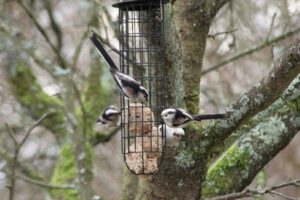
There are numerous ways of presenting seeds to birds. For example, there are fat balls, which you have surely seen before. They usually come in nets so you can hang them in trees. Many people don’t know that these nets can be dangerous for birds – smaller ones could get stuck in them, and bigger ones, like seagulls, could swallow the plastic. Those hungry giants tend to eat without thinking because what’s down their throats can’t be stolen from them anymore. The plastic, however, remains inside the bird’s body and causes the bird to no longer feel hungry, which could lead to starvation. Instead, you can put fat balls in birdfeeders like in the picture. The smaller birds will enjoy eating them just as much; only the bigger birds won’t have access. But we don’t want to forget them either, do we?
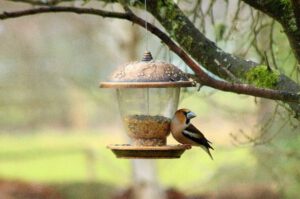
When it comes to bigger birds, you can put seeds on the ground so they can reach them easily. You could also turn a bowl upside down and put some seeds on top of it, like a tiny table. You can also build a birdhouse – which is a great, creative activity popular with all age groups. Many birds in my garden especially enjoy a hopper feeder – they can land on it for just a second, pick a seed, and fly off into a safe tree.
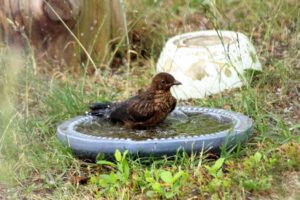
There are a few precautions you should take so that you don’t harm the birds. For example, you should never feed them milk as they are not able to digest it. Instead, offer them water. You may want to put up a fancy bird bath, which would be super decorative in your garden. But you could also put out a plate or a bowl filled with water. Since birds like to bathe in the water, make sure to change the water and clean the bowl regularly. You wouldn’t want a dirty bathtub, would you? Finally, food such as salty treats, desiccated coconut, and mealworms shouldn’t be offered as they cause stomach problems.
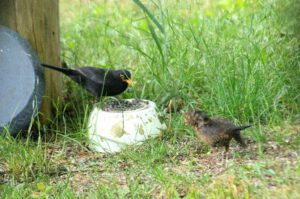
And what happens when February’s over? Well, bird-feeding doesn’t have to be limited to a special time of the year. Back in the day, we used to feed birds only in winter when there weren’t any insects to eat. But with the number of birds constantly decreasing, you might as well support them all year long. Helping out by providing food and water will also increase the chances for hatchlings to grow up and survive.
Apart from feeding, you can take many other steps to make birds feel at home in your yard. Here are some instructions on how to make your home more bird-friendly: https://www.audubon.org/magazine/spring-2022/seven-ways-make-your-home-more-bird-friendly
If you’d like to learn more and want to find further ways to help birds in your yard, the Audubon Society offers a lot of inspiration. They’re a scientific organization that aims to protect birds and educate people. They offer magazines and an app for bird identification so that you’ll know who exactly is feasting on your seeds. On their website, they also show fun activities, like how you can make a birdbath or your own suet: https://www.audubon.org/get-outside/activities
Now it’s time to get started and help wild birds. Have lots of fun feeding them!
6,230 Total Views, 9 Views Today






